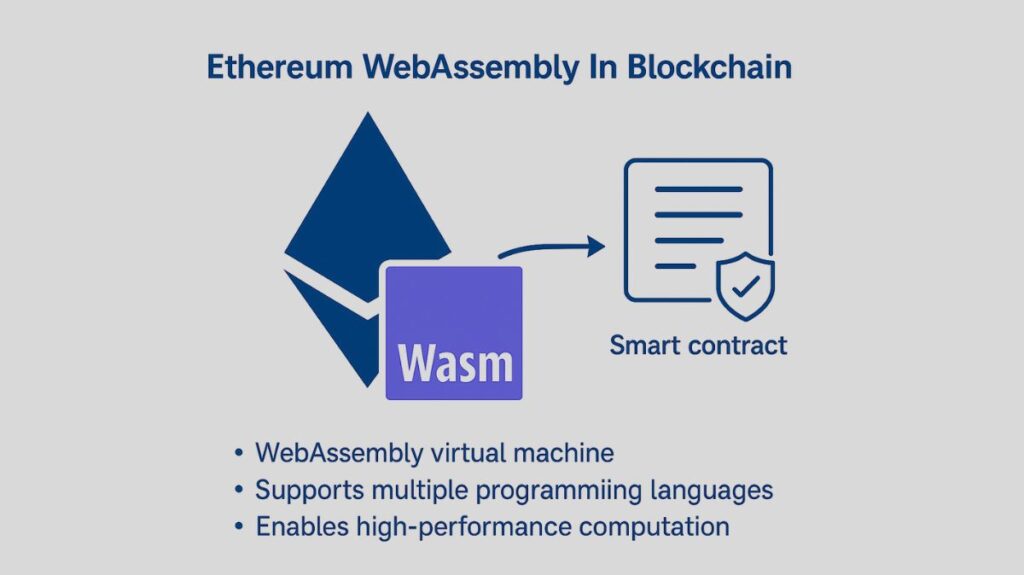What is ewasm?

Making use of a deterministic subset of WebAssembly (Wasm), Ethereum WebAssembly (ewasm) is a proposed redesign of the Ethereum smart contract execution layer. It is a version of WebAssembly that was created as a new backend and alternate environment for Ethereum programming to run in. Ewasm’s main objective is to improve smart contract execution speed and efficiency by utilizing WebAssembly’s existing toolchain and optimizations. This is in contrast to the Ethereum Virtual Machine (EVM) that is currently in use.
Why is eWASM being used?
There are several reasons why Ethereum 2.0 is using eWASM:
- Efficiency: It is intended that eWASM will be more efficient than the existing EVM bytecode. Transactions will therefore be less expensive and quicker.
- Security: Modern EVM bytecode is less safe than eWASM. Due to its modern design, it is less attackable.
- Portability: Due to its portability, eWASM can run in web browsers. This helps developers build Ethereum apps.
What are the benefits of using eWASM?
For Ethereum 2.0, there are several advantages to use eWASM:
- Faster transactions: Transactions will be more affordable and quicker using eWASM. This will increase Ethereum’s usability for more applications.
- More secure platform: Ethereum will be safer with eWASM. As a result, both developers and users will find it a more appealing platform.
- More developer friendly: In comparison to the current EVM bytecode, eWASM is more developer-friendly. This will facilitate the development of Ethereum-based applications by developers.
How will eWASM work?
eWASM will be utilised to execute Ethereum 2.0 smart contracts. Contracts that execute themselves and are kept on the blockchain are known as smart contracts. Many functions, including delivering money, managing assets, and casting ballots in elections, can be automated with them.
Core Purpose and Background
Currently, ewasm is being researched and developed as a substitute for the Ethereum Virtual Machine (EVM) as an execution environment. By working with standard hardware, it achieves its design goals of speed, efficiency, and portability. Because of the EVM’s execution model’s preference for simplicity above performance, ewasm is the result of ongoing efforts to further optimize EVM execution for increased performance.
Leveraging WebAssembly (Wasm)
Microsoft, Mozilla, and Google created WebAssembly (Wasm), a binary instruction format that is currently an open standard maintained by the W3C community organization. Wasm wants machine code to run at speeds close to native in the browser. By utilizing this feature, ewasm hopes to accelerate the execution of smart contracts. Because Wasm converts code into binaries, it executes code efficiently and offers faster performance that is on par with native execution. Platform-neutral Wasm differs from Ethereum’s EVM. Smart contracts may now be written in C language, C++, and Rust, enabling compatibility and flexibility. Smart contracts using WebAssembly have access to the toolchain and a huge development community.
Role in Ethereum 2.0 (Serenity)
The implementation of ewasm is an essential component of the Ethereum 2.0 (Serenity) vision, collaborating with sharding and Proof of Stake (PoS) to enhance the balance between security, scalability, and decentralization. It is essential to Ethereum 2.0’s Phase 2, which is centerd on cross-shard communication and execution environment enhancements. The Ethereum 2.0 architecture’s Phase 2 envisions each shard chain having its own ewasm EVM, which will speed up the execution of smart contracts. Both the new ewasm format and the current EVM format of smart contract code are anticipated to be supported and executed by Ethereum nodes once they are put into use.
Comparison with the Ethereum Virtual Machine (EVM)
All Ethereum programming runs on the Ethereum Virtual Machine (EVM), a low-level, stack-based interpreter processing Solidity code converted to bytecode.
To improve security and guarantee deterministic execution, the EVM keeps smart contract code from accessing outside resources by offering a sandboxed and isolated runtime environment. It is made to be big-endian and performs cryptographic calculations using words that are 256 bits wide.
The EVM has been successful, but it has had problems with scalability, high petrol prices, and speed and efficiency constraints.
While ewasm is primarily designed for online apps like Ethereum, the EVM is described as a “jack of all trades master of none”. Ewasm is being developed to tackle these constraints.
Wasm performs quicker than the stack-based interpretation of the EVM because it can compile into binaries.
Current Status
The Ethereum WebAssembly is presently undergoing research and development. Nevertheless, the Ethereum 2.0 Phase 2 specification, which incorporates ewasm, is not yet final and might change. Wasm-based smart contract support is being developed with the development of smart contract engines like Sabre.
Reversing Ewasm Contracts
Smart contract analysis and reverse engineering are feasible with Ewasm (Ethereum flavoured WebAssembly).
